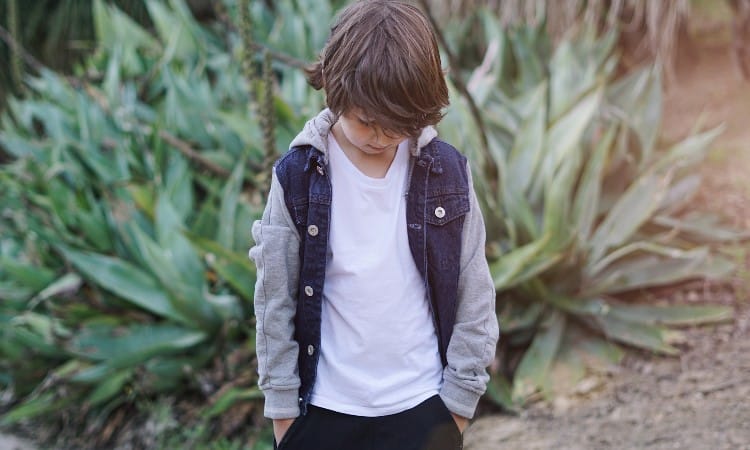Have you ever found the perfect new shirt to wear to work, but then you try it on at home and just can’t tell if it looks too long? Whether you wear your shirts tucked or untucked, the length plays an important role in your overall appearance. Fortunately, this handy guide will show you how long a shirt should be!
Untucked shirts such as t-shirts or straight-edged button-down shirts should fall two inches below the waistband. For men and women, the bottom edge of an untucked shirt should reach the top edge of the waistband when raising both arms. Shirts tucked in should have tails reaching the lower edge of the seat.
In this article, you will learn about standard shirt lengths. You will find out how long a shirt should be for men, women, and children. Finally, you will find tips on how to get the correct shirt length for your height.

Quick Navigation
Standard Shirt Lengths
Standard shirt lengths for men and women will give you a clear idea of how certain styles of shirts fit your body. Of course, specific measurements vary from brand to brand because clothing manufacturers have never sat down and agreed to use the same shirt lengths! But generally, you can look for a few key factors in shirt lengths.
For men’s button-down dress shirts meant to tuck in, standard lengths typically fall between 28 to 32 inches for sizes S-XL. To measure the length of a dress shirt, you trace a straight line from the point where the shoulder seam meets the collar down to the hem at the front of the shirt.
Women’s button-downs and t-shirts usually have a length that falls between 20 and 28 inches on the small-to-extra-large sizing metric. Women’s shirts also use a length measurement that traces a line from the shoulder to the lowest point of the hem at the front of the shirt. But in this case, the measurement should follow the curve of the body, as the length of the shirt also accommodates the outline of the bust.
Many shirt styles fall outside these typical length rules, though. For example, men’s button-downs with a straight hem that you can wear untucked usually come in a slightly shorter length. Women’s blouses may have a variety of unique shapes, such as a loose, billowy lower hem meant to poof out above the waistline.
Because you can find many shirt styles variations, it may seem impossible to pin down the perfect shirt length for you. But don’t worry–the next section will provide helpful strategies to help you get that perfect length!
How Long Should a Shirt Be

A shirt should be long enough to raise both arms without the hem of the shirt lifting above the waistband of your pants, as a general rule of thumb. This holds true for men’s and women’s dress shirts and t-shirts, though some specialty shirts, like certain types of blouses for women, may have exceptions to the rule.
1. For Men
You can learn how to take a few simple measurements that will help you find the best shirt length for men. Check out these tips for measuring untucked and tucked shirts.
Untucked
Untucked shirts should reach midway down the fly of your pants and midway down your seat as well, in most cases. Keep in mind that you do not want to wear a shirt with a rounded hem untucked–that often looks sloppy. Instead, select a shorter one with a flat or slightly curved hem and a shorter length to wear untucked.
One of the tricky things about wearing a shirt untucked, though, is that the back hem can ride up if you select a shirt that hangs a hair too short. The best way to find the right untucked shirt length is to take a back length measurement.
- Measure a shirt that fits you perfectly when worn untucked. Try the shirt in front of a mirror and check out the front hemline to see if it hangs to the middle of your pants zipper. Then turn around to find out if the back hem reaches comfortably halfway down your posterior.
- Next, take off the shirt and smooth it out on a flat surface, with the back of the shirt facing up at you.
- Use a flexible tape measure to measure the back length of the shirt. Start by locating the bottom edge of the collar, right at the center of it. Measure the distance from that point straight down the back of the shirt to the bottom edge of the hem.
- Write down that measurement and compare it to any new shirts you want to wear untucked to make sure they will have the correct back length.
Tucked
A shirt meant to wear tucked in should hang just past your posterior in the back and reach the end of your zipper in the front. If the shirt hangs much lower than this, it will scrunch up and look poofy inside your pants when you tuck it in. But if you choose a shirt much shorter than that golden length, it will keep coming untucked as you stand and sit during the day.
Most traditional button-down or dress shirts for men have rounded hems meant to wear tucked into your pants. These shirts typically have a longer length so that you have enough extra fabric to slot inside the waistband of your pants.
The quickest way to make sure a tuck-in dress shirt has the right length for you is to measure its front length.
- Put on a dress shirt that you like. Look in a mirror to make sure that the front hem reaches just the end of the fly in your pants.
- Take off the shirt and smooth it out on a table with the front facing up at you.
- Locate the point where the shoulder meets the collar, right about where the base of your neck sits as you wear the shirt.
- Use a tape measure to measure the distance between that point and the hem at the bottom of the shirt.
- Use that measurement for the shirt length when you read the product description online for any new shirts you want to order!
2. For Big and Tall
Shirts marked as Tall or Big and Tall should have a length that measures at least two inches longer than average shirt lengths for the size. Of course, this can vary from one brand to another.
One of the challenges of buying big and tall shirts is that you often find brands that make a shirt broader without making it much longer when you get into 3XL, 4XL, and 5XL shirts.
Check out these tips to help you find the right tall, big, or big and tall shirt with the right length for you.
- Tall shirts work best for people with a waist circumference smaller than their chest measurement and a height greater than 6’ (though some brands list the preferred height as 6’3”, so check on this before making a purchase). These shirts use the same shape and overall sizing as average shirts but add one to two inches of length to the hem.
- Though you do not see this as often, Big clothing typically features broader measurements than average. For example, a Big-sized 3X shirt might have an extra inch in the chest compared to a regular 3XL shirt or a wider neck opening. These clothes fit best on people under 6’2” as the garments do not typically include any extra length.
- Big and Tall shirts factor in both added length and width in clothing sizes. If you stand taller than 6’2” and have a waist size over 40 inches, you probably want to shop in Big and Tall sizes.
The tricky thing about shopping for clothes in any of these categories is that brick-and-mortar stores do not often differentiate them well. They typically just rack all the “XL” clothing in the same place. So make sure you read the labels to find accurate sizing info, or go online and read product descriptions.
3. For Women

There is less of a hard-and-fast rule about how long a shirt should be for women because women’s shirts come in so many different styles. That said, in most settings, you want a shirt long enough that you can raise your arms without exposing your midriff, which does give you guidelines to go by.
Another thing to keep in mind when considering shirt length for women is that the shape of the shirt can impact its length, too. Many shirts for women contain shaping elements like concave side seams, darts, or tucks that give the front of the shirt a curved shape.
T-shirt Length for Women

The best t-shirt length for women is just a couple of inches below your waistband but not lower than your hip. The goal is to have the shirt reach past the top edge of your waistband so you can move around easily but not hang so long that it wrinkles up and looks weird as you sit and stand.
This does vary a lot based on style preferences, though! Big, baggy tees constantly remain in style, for example, and you do typically want those to hang past your hips.
4. For Boys

For boys, a safe rule to follow is that the bottom hem of any kind of shirt should reach two inches below the top edge of the waistband on the pants. You can use this rule for t-shirts, untucked cute little-guy polo, or button-downs!
For teens, style rules go out the window because fashion trends come and go so quickly. For instance, teens today might want to wear a massively long tee paired with related-cut jeans and sneakers. In this case, the shirt will hang much longer than two inches past the waistband.
What Length Should a Shirt Sleeve Be?
Correct shirt sleeve length varies based on the style of sleeves in question. Check out these tips to get an idea of how shirt sleeves should fit you for each different kind of shirt.
- For men’s dress shirts, the lowest edge of the cuff should reach the first knuckle on your thumb when you stand with your arms relaxed at your sides. This gives you extra wiggle room to bend your arms without the cuffs shooting up above your wrists.
- For women’s dress shirts, the cuff should end just below the wrist bone.
- For short sleeve shirts like tees and polos, you want the end of the short sleeve to hit midway down your bicep. If the sleeve reaches your elbow, it will look as if the shirt is too big for you.
- For women’s blouses, you can find sleeves in every style ranging from cap sleeves to three-quarter sleeves to full-length sleeves. Out of all of these, three-quarter sleeves that reach below your elbow tend to look the most flattering on most body types.
Length of Shirt for Height
This guide will give you an overview of the shirt length to look for based on your height. Everyone has different proportions of the torso to legs, though, so there is no perfect ratio of shirt length. The best way to get a shirt in the right length is to use the measuring method described earlier in this article and then make sure you buy new shirts that match that length.
| Size | Height | Shirt Length |
| S | 5’3” to 5’6” | 25.5” |
| M | 5’6” to 5’8” | 26” |
| L | 5’8” to 6’ | 27” |
| XL | 6’ to 6’ 2” | 27.5” |
You can also find free online calculators like this one that will estimate your shirt size based on height and weight. This can help you a lot, especially if you don’t know whether you should get a Tall or a Big and Tall size.
What Length of Shirt is Most Flattering?
Different lengths of shirts will look best on you depending on your body type, but you can always follow the flattering rule of the ⅓ to ⅔ Golden Ratio to help pick a good shirt length for your body.
For men and women, the Golden Ratio of ⅓ to ⅔ may help you find the correct shirt length. This fashion industry concept means that the top portion of your outfit, such as your shirt, should form only ⅓ of the overall length of the outfit. The remaining ⅔ of the length belongs to your pants, skirt, or other lower-body wear.
Why does this work? Breaking your lengths into thirds makes you look taller and slimmer than breaking yourself in half by having a length of a shirt that seems almost as long as your pants!
The best tip you can learn about finding a flattering shirt length is to wear tops that end at a skinnier portion of your body. If you have curvy hips, wearing a sweater or shirt that ends right in the middle of that curve will draw the eye to the widest portion of your body instead of a narrow portion. Instead, wear a top that ends where you curve in, such as at the waist or below the hip.
How to Know if a Shirt is Too Long?
Look in a mirror and see where the lowest edge of the shirt hits your body to find out if a shirt is too long for you. Most of the time, you want the hem to hit you about midway down your posterior.
Check out these tips to make sure your shirts do not look too big!
- For any kind of shirt you want to wear tucked-in, the shirt is too long if it hangs lower than your posterior. While you need some excess at the hem of the shirt to tuck it in comfortably, too much fabric will gather up inside your pants and look bunchy from the outside.
- For an untucked shirt, you usually want the hem to fall a few inches below the waistline of your pants or shorts. A hemline that falls as low as the bottom of the zipper in your pants will likely look overlarge.
- For any kind of semi-fitted shirt like a t-shirt, polo, or button-down, the shoulder seam where the sleeve attaches to the shirt should always fall right at the end of your shoulder.
- Unless you want to rock a trendy oversized look, such as the boyfriend cardigan vibe, do not wear long-sleeved shirts with sleeves that extend past your knuckles. This makes the whole shirt look too big for you.
How to Tell if a Shirt is Too Short?
The quickest way to tell if your shirt is too short is to raise both of your arms overhead while standing in front of a mirror and check to see if the raised shirt has exposed any skin above the waistline of your pants.
- If you struggle to find shirts in the right length for a rounded or curvier body type, stand back from a mirror to double-check if the shirt exposes any of the skin of your belly as you wear it. If so, the shirt is too short for you.
- If you feel the cool air on the skin of your lower back when you sit down, the lower edge of the shirt has ridden up your back and left exposed skin. This usually means the shirt is too short or too tight.
- If you need to move around a lot during the day, you may want to play it safe and wear a shirt that hangs comfortably lower than the waistband of your pants or skirt to make sure that it will not pop up unexpectedly and expose your midriff at an awkward moment.
What Color Shirts Make You Look Taller?
You can pick certain colors of shirts to make yourself look taller, such as dressing in monochromatic dark shades or wearing boldly contrasted tops and bottoms in an outfit.
Monochromatic outfits pairing black or navy shirts and pants can make you look skinnier and taller. Turning yourself into one solid pillar of color forces people to look at you vertically, in a straight line.
The opposite also holds true, though, because you can sometimes make yourself look taller by wearing a shirt in a bold or dark color paired with light-colored pants. This trick works because the boldly colored shirt will draw attention away from your legs, making them look like they form more of your overall proportion.
You can also go with the tried-and-true vertically striped shirt, as vertical stripes tend to make viewers look at you up and down rather than side to side.
How Should a Shirt Fit?
A shirt should fit you on the shoulders, in length, and the sleeves.
Whether you wear a frilly blouse, a tee, or a dress shirt, the shoulders of the shirt should exactly match up with the endpoint of your shoulders. When you feel the seam that connects the sleeve to the shirt, it should lie on top of the point where your shoulder ends and your arm begins.
Second, the length of the shirt will determine whether or not the garment looks too big or too small for your body. In most cases, aim for a shirt hem that ends halfway down the length of the zipper in your pants. Or measure two inches below the waistband in your pants, shorts, or skirt to find the ideal length of an untucked shirt.
The width of a shirt varies a lot depending on what style of shirt you want. For tees, try pinching the loose fabric at both side seams. You should find it easy to gather at least an inch on each side for a comfortable fit. But for a fitted dress shirt, the fabric should rest closer to your body at both side seams.
Finally, you also want to make sure the sleeve length fits your body. For short sleeves, do the sleeves end midway down the length of your bicep? For long sleeves, you often want the sleeve to end just below your wristbone. The exception is dress shirts for men, which should end at the first knuckle on your thumb.
Conclusion
A shirt should be long enough to lift your arms overhead without the hem of the shirt clearing the top of your waistband. This general rule of thumb can help you find tucked or untucked shirts that fit you properly. Another golden rule you can go by is to measure two inches down from your waistband and make sure the hem of the shirt reaches that point.
Shirts that you want to wear tucked in need a longer length in the hem to remain tucked in all day. For these, look for a hemline that reaches the lower edge of your posterior. Shirts you want to wear untucked should fall past your waistband but not all the way down your hip.